Choosing the Right Castors

How to measure your Castors
1. Measure the Wheel Diameter – the bigger the wheel the easier it is to move!
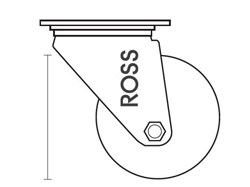
2. Choose the Castor Type - either Top Plate, Bolt Hole or Threaded Stem.
This is all about how you want to fix your castor to your unit, and how much weight each castor is expected to carry.
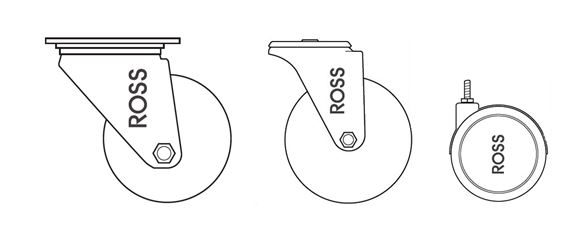
3. Fixing Dimensions
Measure your top plate dimensions, in order to match any replacement castors. Alternatively measure your bolt dimensions or your threaded stem size. Also measure your fixing bolt size (D1) as we can supply fixing bolts and nuts. In order to measure thread size, simply measure the diameter of the thread, 8mm diameter equates to an M8 thread.

Top Plate Castors are fixed to your unit by 4 fixing bolts per castor, supplied seperately. Bolt Hole castors can attach either by using a threaded bolt or a tubular adaptor. Threaded Stem Castors are supplied with a stem that can screw into your equipment.
Top Tip! Attaching castors into round and square tube can be achieved by using bolt hole castors and castor tube adaptors.
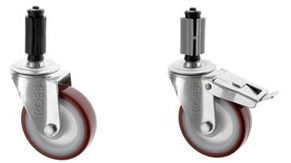
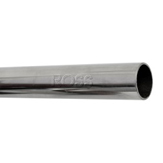
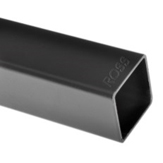
We have a variety of sizes both in the round and square tubular expanding adaptor fittings and these can be found on our Accessories page. In order to choose the correct adaptor for your hollow tube, please follow the following steps
- Is your hollow tubular leg round or square?
- Measure the internal diameter of your hollow tube
- Choose the expander fitting with the range of internal diameters to suit your tube.
| Round Expander To Suit Internal Diam. RangeItem Code | Item Code |
| 18mm - 19.5mm | R-18 |
| 19.5mm - 21.7mm | R-20 |
| 21.7mm - 24.5mm | R-22 |
| 24.5mm - 27mm | R-25 |
| 27mm - 29.5mm | R-27 |
| 29.5mm - 32mm | R-30 |
| Square Expander To Suit Internal Diam. Range | Item Code |
| 20mm -22mm | S-20 |
| 22mm - 25mm | S-22 |
| 25mm - 28mm | S-25 |
| 29mm - 32mm | S-29 |
| 36mm - 38mm | S-36 |
4. Choose your Wheel material

Top Tip! General rule of thumb is soft wheels on hard floors and hard wheels on soft floor surfaces. Soft wheels are rubber, and hard wheels are nylon and polyurethane. Pneumatics and puncture proof wheels are ideal for outdoor applications. For more information on wheels, take a look at our Wheel Measurement Section.
5. Castor Configuration -Swivel, Fixed or Braked Castors
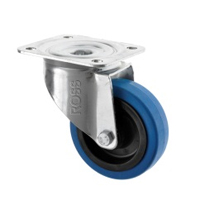
Swivel
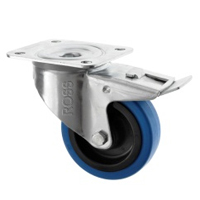
Swivel with Brake
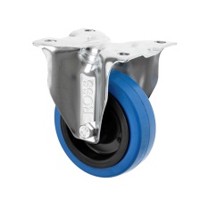
Fixed
Bolt Hole Castors - are available as a swivel and swivel with brake versions only
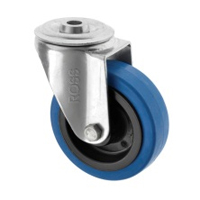
Swivel
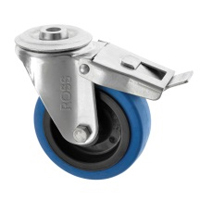
Swivel with Brake
Top Tip! The following configurations are the most popular
- Four Swivel Castors - for the maximum manoeuvrability, but may be difficult to control on a straight run and not ideal for very heavy loads.
- Two Swivel Castors and Two Fixed Castors - the most popular configuration as it provides the best control coupled with manoeuvrability.
- Two Swivel Castors with Brakes and Two Fixed Castors- again the most popular option as it gives good control and manoeuvrability, and allows the items to be locked into a specific location as required.
6. Check the Load Capacities – for a 4 castor trolley
Having an understanding of the weight you want the castors to support and move is a vital consideration! Use the following calculation
Max Load each castor needs to carry = (unit weight + max extra load) ÷3
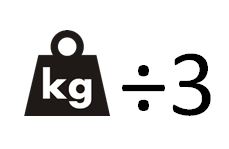
Top tip! Dividing your total load by 3 allows for a margin of safety, and this will give you the maximum each castor can carry in a safe working environment, allowing for uneven floor surfaces.
7 . Other Considerations that may affect your choice?
Swivel Radius - The distance from the centre of the castor head fitting to the outside of the wheel. This measurement enables you to ensure you have enough clearance for the complete castor to rotate, without being fouled. It is important to take this into consideration when deciding where to attach the castor. Please note braked castors have slightly larger swivel radiuses, as a result of the foot brake mechanisms.
Floor Surfaces - All our stated load ratings for our castor ranges are based upon the assumption that the floor surface is reasonably level. Any obstructions, ridges, cracks or dirt will affect the load rating and efficiency of the castors. Careful consideration of Wheel Type in your castors is important and discussed in more detail below.
Health & Safety - All our castors are designed for low speed applications, and power towing castors are available upon special request. It is important to select the right castor for the job, to protect against manual handling injuries.
Bearings - Choosing castors and wheels with bearings, makes them easier to move, however in certain outdoor and offshore environments standard bearings may cease. Call us for information on stainless steel bearings.
Temperature - We offer a specialist range of Temperature Resistant castors that can withstand high temperatures in ovens, kilns and foundries. These castors can also withstand low temperatures such as in freezers and outdoor environments.





